School Specimens
The Post Office training school was set up in 1920. It needed to train new staff in the use of all PO procedures and materials, including, of course, stamps. To avoid theft (and, it is alleged, "to save the trouble of having to account for the stamps used") the materials were defaced in some way. Some material had a hole punched in it, some was overprinted "cancelled", but the predominant defacement was one or more black lines applied either by roller or plate. The PO did not particularly care about philatelic changes such as watermarks but just trained its staff on whatever material was in use at the time, overprinting new stocks for their courses as and when the need arose. Almost all "basic" stamps therefore exist with the training bars, from the "script cypher" George V definitives to the present day. It is clear that quite often the training courses used up items of irregular size, for example left-over bits of coils and booklet sheets, misprinted sheets, and so on which could not be distributed to post offices but were suitable for training (for example tete-beche pairs are known, though the effect of these on PO trainees is not recorded).

A typical "black bars" anti-theft obliteration from training material.
Of more interest to the "GB Overprints" collectors are the much smaller number of items handstamped with the words "School Specimen" instead of the black bars. It is not known exactly why this overprint was introduced, and under what circumstances it was used instead of the bars. There are several types of the overprint, some of which only appear on stationery and other non stamp items (eg postal orders) Although they can be found on pre-decimal Machins, they appear to have stopped at about the time of decimalisation. The exact date for the introduction of the "School Specimen" handstamp is not known, but the earliest known issue is the ½d dark green of the George VI set; it has been suggested that this, and the overprints on the pale colours and 1950 changed colours are a "residue of stamps of this reign used in the training school just prior to stamps of the new reign", but that is just a hypothesis. All stamps with the overprint are scarcer than the same values with black bars, sometimes considerably so. However, there is a strong assumption that some items are bogus, and they are, of course, very easy to forge; for example it is notable that the overprints on many of the George 6 stamps appear to have exactly the same overprint (with the same amount of wear and tear) as the early decimal Machins, which seems strange over a period of 20 years.

The three most commonly offered formats of the overprint. Others fonts and layouts exist, some of which may well be bogus. As indeed may some with the formats illustrated here - let the buyer beware!
King George 6
dark colour low values
½d known, but very scarce
pale colour low values
some values, but scarce
changed colours
all values, quite scarce
Queen Elizabeth
Tudor crown E2R
all sheet values (different types of overprint are reported)
St Edward's crown E2R
all sheet values (different types of overprint are reported)
multiple crowns, non-phosphor paper
all values from sheets, some values from coils and booklets
graphite lines, crown watermark
1d coil
phosphor lines
sporadic values, various colours of phosphor, sheet, coil and booklets.
Note: on the 2/- booklets (with sideways watermarks) and some coils with sideways stamps the overprint is also sideways.
Castles
St Edward's crown E2R De La Rue printings
multiple crowns (De La Rue) and no watermark
Machin pre-decimals
all values, sheets, booklets and coils, including the "pre-decimal" 20p, 50p, £1 high-values.
Commemoratives
sporadic values from the 1946 2½d Victory stamp to the 1970 4d Christmas stamp.
Postage dues
odd values reported
Revenue stamps
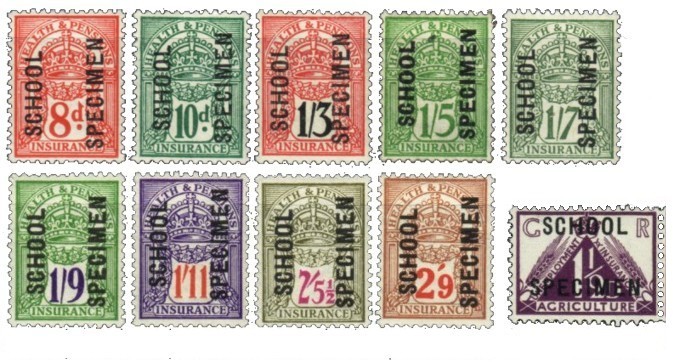
(selection of National Insurance overprints)
Barefoot (2002) mentions "School Specimen" overprints as existing for civil service training in the use of revenues for "Health & Pensions Insurance" (1925), "Unemployment Insurance", "Agriculture Unemployment Insurance" (1936), "Contract Note" (1946), "Civil Service" (1947).
The overprint can also be found on TV licence stamps and savings stamps (the early squirrel design).
Postal Orders
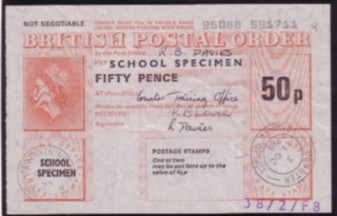
large overprint
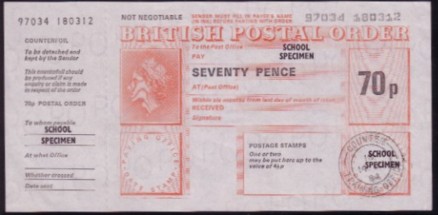
small overprint
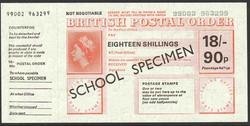
the very large overprint used on dual currency issues.
The "School Specimen" overprint can be found on many Queen Elizabeth postal orders, but is particularly common on the dual-currency values for which (presumably) extra training was required: a huge remainder stock of these was reported to have been discovered later which explains the frequency with which they come on the market (these have a very large diagonal overprint). Copies from other issues are much less common.
Postal Stationery

The overprint can be found (in various fonts) on official postal stationery, especially letter cards and registered envelopes. For some reason the 2½d Queen Elizabeth letter card overprinted "School Specimen" uprated by one (or sometimes 2) ½d stamps with black bars, seems to be particularly plentiful -- presumably there was some intensive training at the time of the uprating of the postal rates.
Other training material


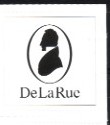
Other training material falls outside the remit of "GB Overprints", but includes dummy stamps for decimal low-values, dummy self-adhesive stamps, and "School Specimen" registration labels and other postal ephemera.
page last updated on: 6 July 2006
gbos: GB Overprints Society
